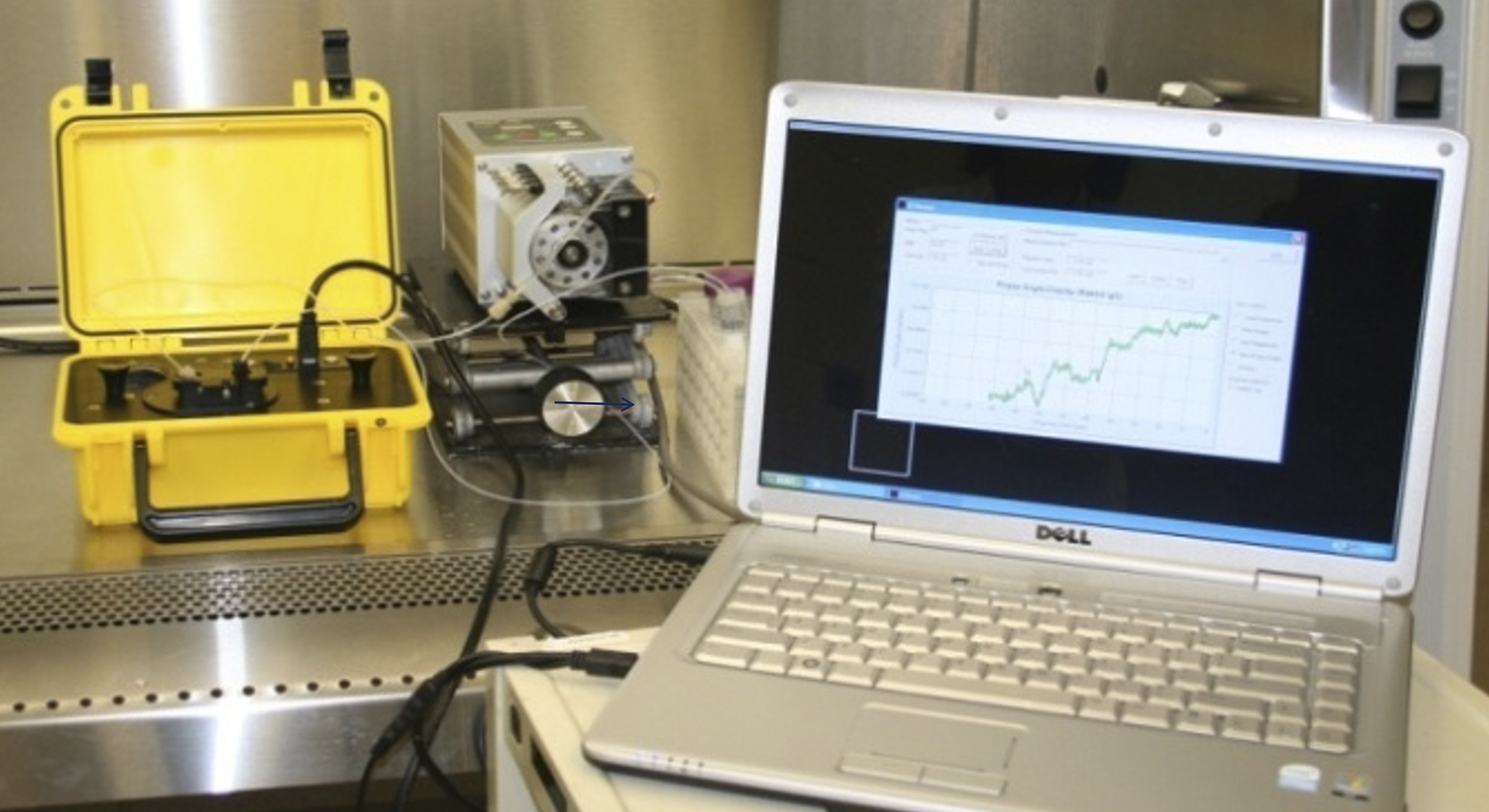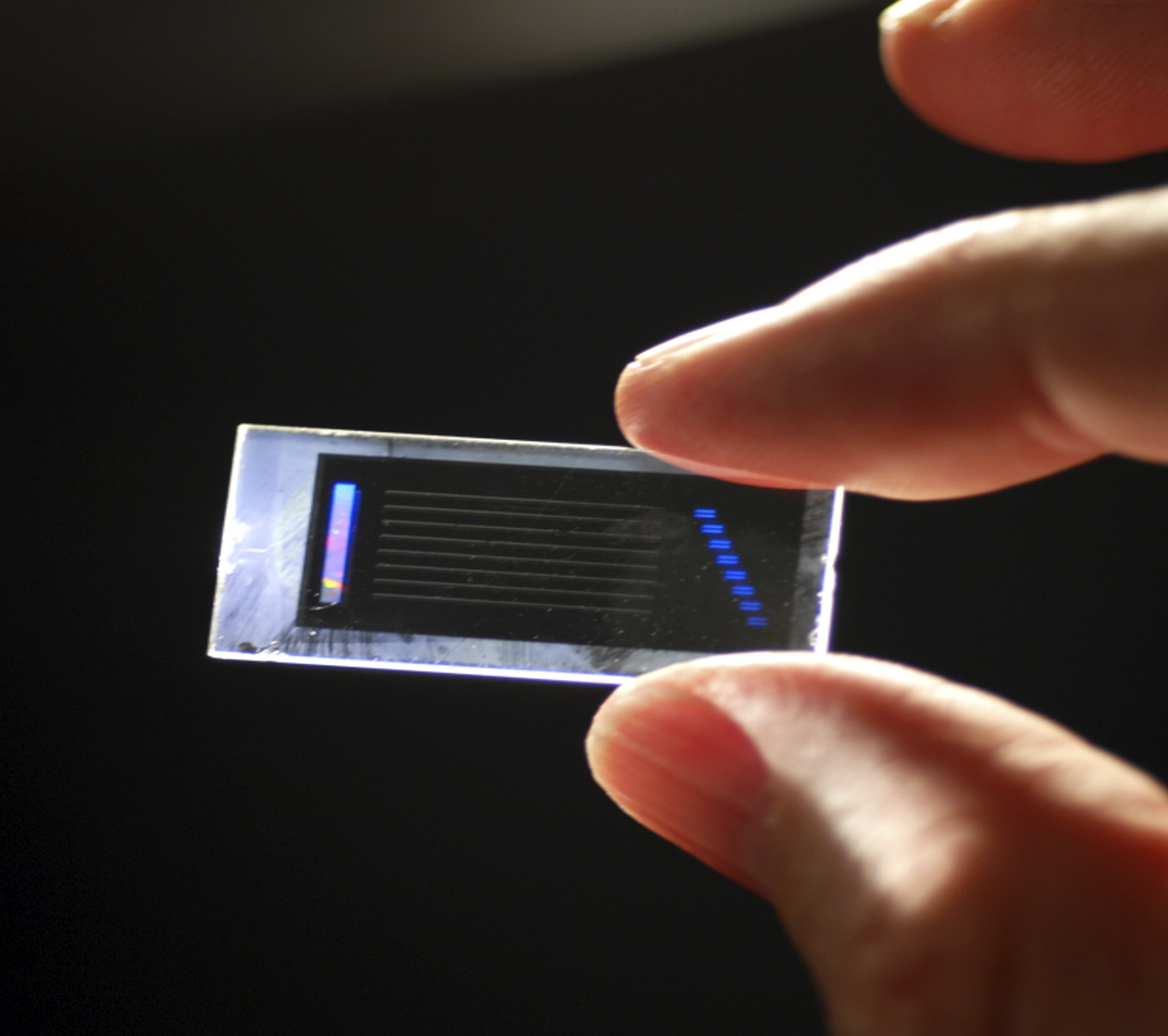The rapid, accurate, and specific detection of various diseases, viruses, and chemicals has long been an objective of the medical, animal health, chemical, and agricultural industries globally. Often, developed detection technologies and methods can achieve only two of the three objectives (speed, accuracy, specificity), with RNA-based PCR approaches being commonly accepted as the most robust in terms of diagnostic accuracy and specificity. However, the ability to successfully meet all three objectives simultaneously has remained somewhat illusive for diagnostic and chemical applications alike. Through many years of research and development, researchers at the Georgia Tech Research Institute (GTRI) have refined a technology that holds promise for reducing the tradeoff between speed, accuracy, and specificity. This technology is an innovative interferometric biosensor that can be configured to rapidly detect a variety of pathogens and chemicals.
How It Works
The science behind the sensor is a concept known as interferometry that exploits the interference of light waves to precisely determine the rate at which target particles attach to the sensor’s surface. Specifically, light from a laser diode is coupled into an optical waveguide through a grating and travels under one sensing channel and one reference channel. The best way to visualize this is to think about a microscope-like glass slide with two little troughs etched onto the surface with a laser light shining into one end of the slide.
For virus detection, the sensing channel (the first trough) is coated with an antibody specifically designed to capture a protein (antigen) located on the surface of the viral particle. You can liken the antibody and antigen relationship to a children’s shape puzzle, where only the shapes (or antigens) with specific targeted properties will slot into or attach to the reciprocal holes in the puzzle (the antibodies). This allows the technology to be specific to the virus of interest.
The reference channel (the second trough) is coated with a nonspecific antibody. An electromagnetic field associated with the light beam extends above the waveguide and is very sensitive to the changes caused by antibody-antigen interactions and attachments on the waveguide surface. When a liquid sample passes over the waveguide, any antigens or viral particles that match the antibody coating will bind to the surface of the sensing channel. This antibody-antigen binding causes a change in the velocity of the light traveling through the sensing channel (the first trough) compared to the light traveling through the reference channel (the second trough). The sensor then measures this relative change in the speed of light to determine the rate at which the viral particles are attaching to the waveguide. Based on this, the sensor can calculate the concentration of the targeted virus.
The same science and technology can be applied to many types of detection. Different receptors like RNA, DNA, aptamers, proteins, and polymers will enable detection of microorganisms (virus, bacteria), proteins, nucleic acid, and many chemicals.
Benefits
The benefit of this technology is that the entire process of sample introduction to determining a result can be completed in a manner of minutes or seconds. Compared to RNA-based PCR or GC/MS-based technologies that can take several hours, this is extremely fast. An instrument or device powered by this technology would allow clinicians to very quickly process a patient sample and have results that can be shared before the patient leaves the premises, alleviating the need to send patients home to await lab testing results. In addition, a wide range of samples can be processed by using waveguides specifically engineered with antibodies, RNA, DNA, aptamers, proteins, polymers, and/or chemicals to detect different viruses, diseases, or chemicals. The technology has been tested in more than 50 diverse applications including the detection of Salmonella, Avian Influenza, COVID-19 (both viral particles and antibodies), and many different chemicals.
Commercialization Underway
Recently, Salvus™, LLC, a Valdosta, Georgia-based manufacturer of chemical contaminant and pathogen detection technologies, has signed a licensing agreement to market and manufacture a commercial handheld version of GTRI’s interferometric chemical and biological sensing technology. With the widespread impact of the global pandemic, the initial development, testing, and prototype has focused on the detection of the COVID-19 virus. Salvus will market the sensor as an effective and efficient, field-deployable rapid test device that can be used to detect pathogens or other contaminants in applications across industrial, human and animal health, food and agriculture, and water management markets.
“The combination of minimized sample preparation, ultrasensitive detection, and rapid response positions this optical sensor as a great candidate for point-of-care diagnosis and on-site contaminant detection,” said Jie Xu, GTRI principal research scientist and the director of the interferometric biosensor research team.
“The ability for this sensor platform technology to translate across a wide variety of applications in human health, animal health, and chemical sensing positions it to have potentially significant impact,” said Doug Britton, principal research engineer and manager of the Agricultural Technology Research Program at GTRI.
“The Salvus team has worked closely with GTRI scientists and researchers over a number of years to help overcome technical and commercial challenges for interferometry technology as a detection platform. The timeline to launch is short, and we are excited about the potential value creation across multiple industry sectors. The strategy and goal is to partner with industry leaders in each applicable industry sector to help realize the full potential of the technology,” said Clinton Beeland, president and CEO of Salvus.
Salvus is the latest venture in the CJB family of companies, which serve the food and agriculture, life sciences, and specialty chemical industries. For more information, visit https://www.salvusdetect.com

GTRI’s Interferometric Biosensor.

Multiple interferometers can be assembled on a single waveguide to allow multiple target sensing.
